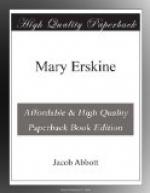“Very well,” said Mrs. Bell, “that makes nineteen hundred.”
“Then,” continued Mary Erskine, “I thought that at the end of the twelve years I should be able to sell this house and the land around it for a hundred dollars, especially if I take good care of the buildings in the mean while.”
“And that makes your two thousand dollars,” said Mrs. Bell.
“Yes,” replied Mary Erskine.
“But suppose you are sick.”
“Oh, if I am sick, or if I die,” rejoined Mary Erskine, “of course that breaks up all my plans. I know I can’t plan against calamities.”
“Well,” said Mrs. Bell, rising from her seat with a smile of satisfaction upon her countenance, “I can’t advise you. But if ever I get into any serious trouble, I shall come to you to advise me.”
So bidding Mary Erskine good-bye, Mrs. Bell called her daughter, and they went together toward their home.
CHAPTER IX.
GOOD MANAGEMENT.
Whenever any person dies, leaving property to be divided among his heirs, and not leaving any valid will to determine the mode of division, the property as has already been said, must be divided on certain principles, established by the law of the land, and under the direction of the Judge of Probate, who has jurisdiction over the county in which the property is situated. The Judge of Probate appoints a person to take charge of the property and divide it among the heirs. This person is called the administrator, or, if a woman, the administratrix. The Judge gives the administrator or the administratrix a paper, which authorises him or her to take charge of the property, which paper is called, “Letters of Administration.” The letters of administration are usually granted to the wife of the deceased, or to his oldest son, or, if there is no wife or son, to the nearest heir who is of proper age and discretion to manage the trust. The person who receives administration is obliged to take a solemn oath before the Judge of Probate, that he will report to the Judge a full account of all the property that belonged to the deceased which shall come to his knowledge. The Judge also appoints three persons to go and examine the property, and make an inventory of it, and appraise every article, so as to know as nearly as possible, how much and what property there is. These persons are called appraisers. The inventory which they make out is lodged in the office of the Judge of Probate, where any person who has an interest in the estate can see it at any time. The administrator usually keeps a copy of the inventory besides.
If among the property left by a person deceased, which is to go in part to children, there are any houses and lands,—a kind of property which is called in law real estate, to distinguish it from moveable property, which is called personal estate,—such real estate cannot be sold, in ordinary cases, by the administrator, without leave from the Judge of Probate. This leave the Judge of Probate will give in cases where it is clearly best for the children that the property should be so sold and the avails of it kept for them, rather than the property itself. All these things Mrs. Bell explained to Mary Erskine, having learned about them herself some years before when her own husband died.




